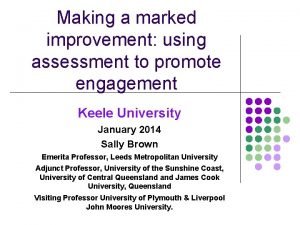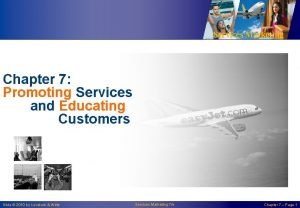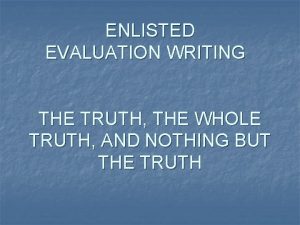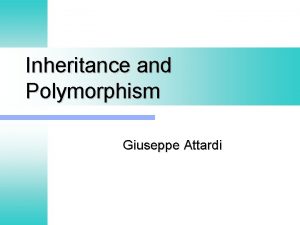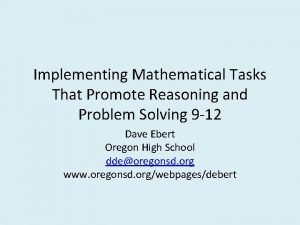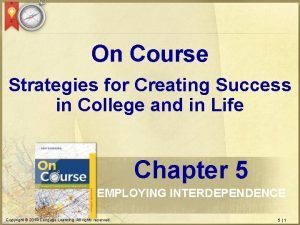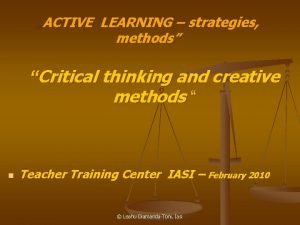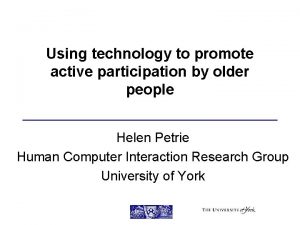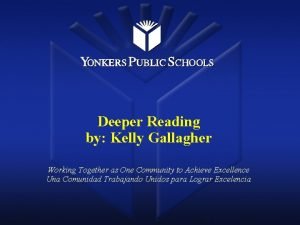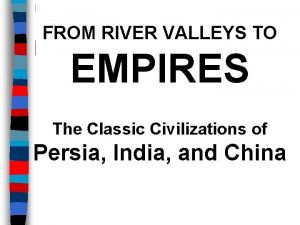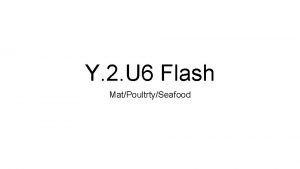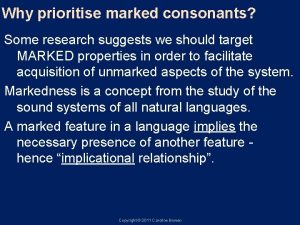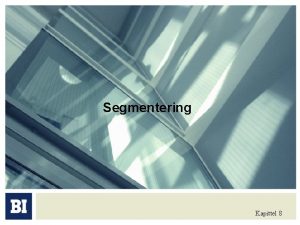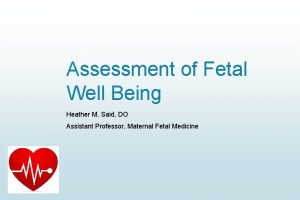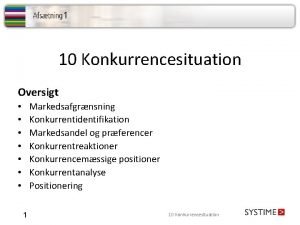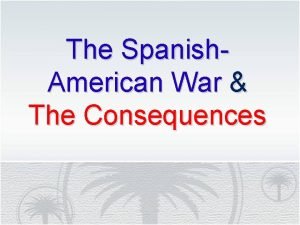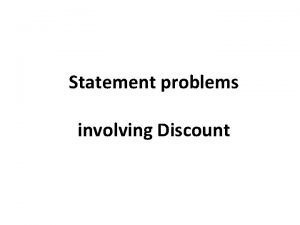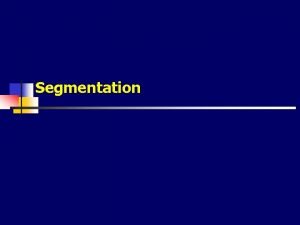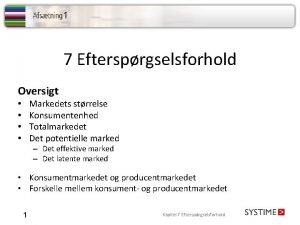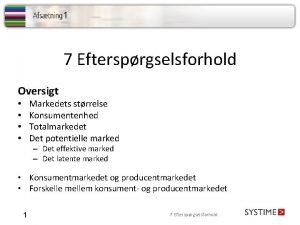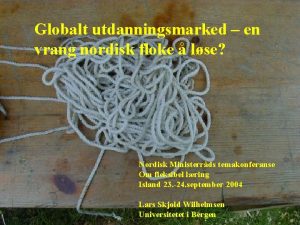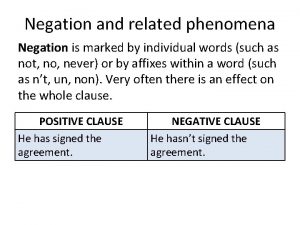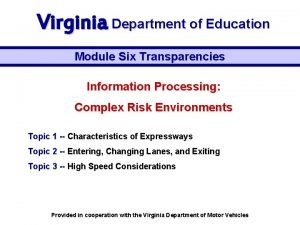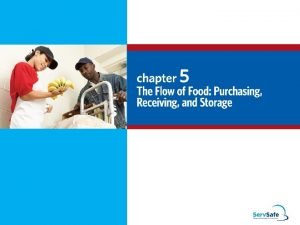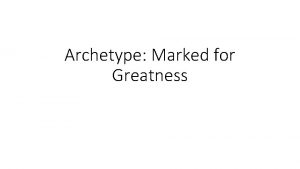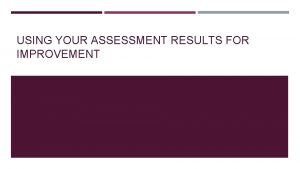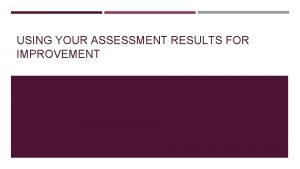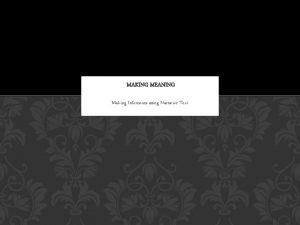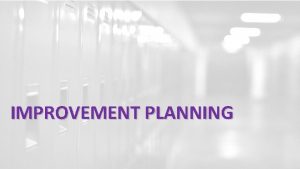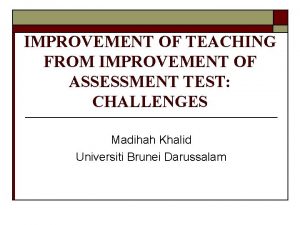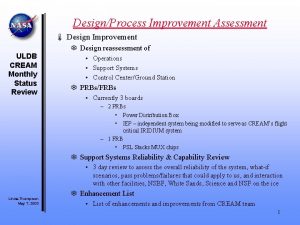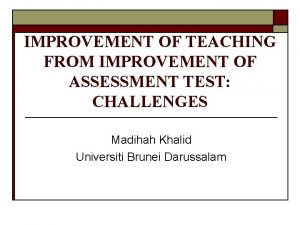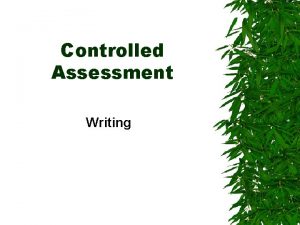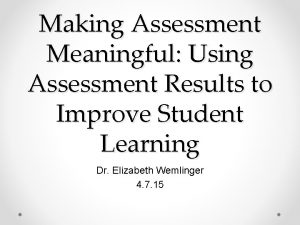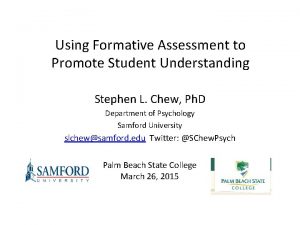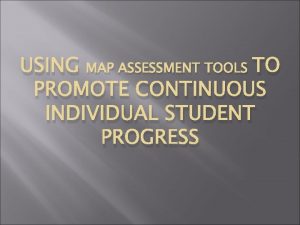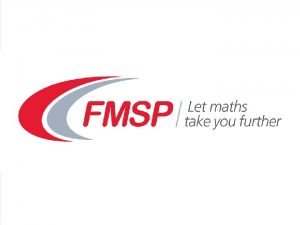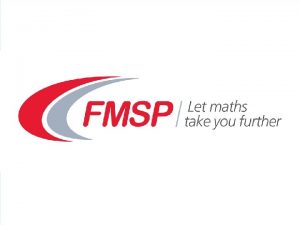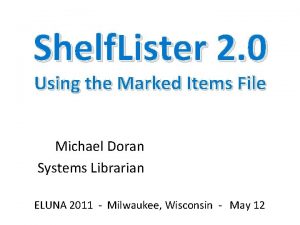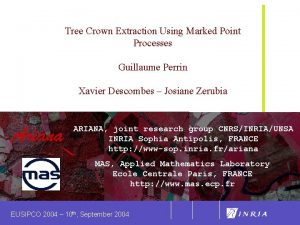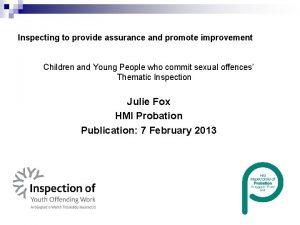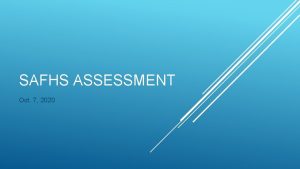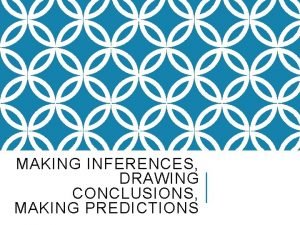Making a marked improvement using assessment to promote















































- Slides: 47

Making a marked improvement: using assessment to promote engagement Keele University January 2014 Sally Brown Emerita Professor, Leeds Metropolitan University Adjunct Professor, University of the Sunshine Coast, University of Central Queensland James Cook University, Queensland Visiting Professor University of Plymouth & Liverpool John Moores University.

Transforming Assessment: a Marked Improvement l l l Keele is one of eight universities within a national HEA-supported initiative working to transform assessment and feedback; This event is designed both to showcase initiatives within Keele and to look to national imperatives on assessment, including the new B 6 section of the QAA code of practice, JISC initiatives and other current developments; Together we are seeking to make assessment contribute to student achievement, engagement and retention by being fit-for-purpose and fully integrated into the learning process

Two major current UK initiatives on assessment to consider l l The UK Quality Assurance Agency (QAA) Code of practice B 6 on Assessment and APL. The Higher Education Academy ‘A marked improvement’ project on bringing about change to institutional strategies on assessment. Both groups have overlapping membership and therefore aligned perspectives. Both initiatives draw on the work of previous generations of thinkers on assessment, and particularly the two Centres for Excellence in Teaching and Learning (CETLs) that focused on assessment, Oxford Brookes’ Assessment Knowledge Exchange (ASKe) and Northumbria's Assessment for Learning (A 4 L).

Engagement with the HEA project: A marked improvement l l It is designed to transform assessment in higher education; The Oxford Brookes CETL ASKe produced the Weston Manor Manifesto which provides a framework for A Marked Improvement; The publication provides a rationale and groundwork for transformation, together with templates enabling institutions to review their own practices and implement change at a university level; The HEA team and internal consultants have worked with the institutional teams through core and targeted forums.

The manifesto for change concentrates on six tenets: 1. 2. 3. 4. 5. 6. Assessment for learning; Ensuring assessment is fit for purpose; Recognition of the imprecision of many assessment practices; Constructing standards in assessment communities; Integrating assessment literacy into course design; Ensuring professional judgments are reliable.


What does assessment for? What can it do? How much does it matter? l l l Many argue nowadays that assessment is crucially an integral part of the learning process rather than just a means of judging the extent to which learning has taken place; Assessment activities can help students get the measure of their achievement and can motivate learning, but can also destroy confidence and undermine already disadvantaged students; As far as I am concerned there is nothing we do for students that has as much impact as assessment and therefore it’s really worth thinking through how it adds value to the learning experience.

Assessment in context l l If we want to improve students’ engagement with learning, a key locus of enhancement can be refreshing our approaches to assessment; Sometimes we need to take a fresh look at our current practice to make sure assessment is for rather than just of learning; Assessment is a complex, nuanced and highly important process; We provide explicit and implicit messages to students and indeed all other stakeholders by how we assess.

UK Quality Code for Higher Education Part B: Assuring and enhancing academic quality Chapter B 6: Assessment of students and the recognition of prior learning The Indicators of Sound Practice: these provide an important agenda for action

The basis for effective assessment (1) Indicator 1 Higher education providers operate effective policies, regulations and processes which ensure that the academic standard for each award of credit or a qualification is rigorously set and maintained at the appropriate level, and that student performance is equitably judged against this standard. Indicator 2 Assessment policies, regulations and processes, including those for the recognition of prior learning, are explicit, transparent and accessible to all intended audiences. Indicator 3 Those who might be eligible for the recognition of prior learning are made aware of the opportunities available, and are supported throughout the process of application and assessment for recognition.

The basis for effective assessment (2) Indicator 4 Higher education providers assure themselves that everyone involved in the assessment of student work, including prior learning, and associated assessment processes is competent to undertake their roles and responsibilities. Indicator 5 Assessment and feedback practices are informed by reflection, consideration of professional practice, and subjectspecific and educational scholarship.

Developing assessment literacy Indicator 6 Staff and students engage in dialogue to promote a shared understanding of the basis on which academic judgements are made. Indicator 7 Students are provided with opportunities to develop an understanding of, and the necessary skills to demonstrate, good academic practice.

Designing assessment Indicator 8 The volume, timing and nature of assessment enable students to demonstrate the extent to which they have achieved the intended learning outcomes. Indicator 9 Feedback on assessment is timely, constructive and developmental. Indicator 10 Through inclusive design wherever possible, and through individual reasonable adjustments wherever required, assessment tasks provide every student with an equal opportunity to demonstrate their achievement.

Conducting assessment Indicator 11 Assessment is carried out securely. Indicator 12 Degree-awarding bodies assure themselves that the standards of their awards are not compromised as a result of conducting assessment in a language other than English.

Marking and moderation Indicator 13 Processes for marking assessments and for moderating marks are clearly articulated and consistently operated by those involved in the assessment process. Indicator 14 Higher education providers operate processes for preventing, identifying, investigating and responding to unacceptable academic practice.

Examination boards and assessment panels Indicator 15 Degree-awarding bodies specify clearly the membership, procedures, powers and accountability of examination boards and assessment panels, including those dealing with the recognition of prior learning; this information is available to all members of such boards. Indicator 16 Boards of examiners/assessment panels apply fairly and consistently regulations for progression within, and transfer between, programmes and for the award of credits and qualifications. Indicator 17 The decisions of examination boards and assessment panels are recorded accurately, and communicated to students promptly and in accordance with stated timescales.

Enhancement of assessment processes Indicator 18 Degree-awarding bodies systematically evaluate and enhance their assessment policies, regulations and processes.

Some thoughts on assessment and feedback l l l Academic staff frequently use a fairly limited range of assessment and feedback methods for individuals and groups, but international pedagogic research suggests that diversity benefits students greatly. To maximise the benefits of formative feedback, a range of streamlined approaches including statement banks and computer based assessments can supplement traditional forms. Students do not always recognize or use feedback well, but assessment dialogues can enhance learning.

Good feedback practice: 1. Helps clarify what good performance is (goals, criteria, expected standards); 2. Facilitates the development of self-assessment (reflection) in learning; 3. Delivers high quality information to students about their learning; 4. Encourages teacher and peer dialogue around learning; 5. Encourages positive motivational beliefs and selfesteem; 6. Provides opportunities to close the gap between current and desired performance; 7. Provides information to teachers that can be used to help shape the teaching.

Encouraging students to take assessment more seriously l l l All assessment needs to be seen to be fair, consistent, reliable, valid and manageable; Many assessment systems fail to clarify for students the purposes of different kinds of assessment activity; Low-stakes early formative assessment helps students, especially those from disadvantaged backgrounds, understand the rules of the game.

Sadler, the most cited author on formative assessment argues: “Students need to be exposed to, and gain experience in making judgements about, a variety of works of different quality. . . They need planned rather than random exposure to exemplars, and experience in making judgements about quality. They need to create verbalised rationales and accounts of how various works could have been done better. Finally, they need to engage in evaluative conversations with teachers and other students. ”

Sadler continues… l Together, these three provide the means by which students can develop a concept of quality that is similar in essence to that which the teacher possesses, and in particular to understand what makes for high quality. Although providing these experiences for students may appear to add more layers to the task of teaching, it is possible to organise this approach to peer assessment so that it becomes a powerful strategy for higher education teaching. Sadler, D. Royce (2010)

Why does assessment matter so much? “Assessment methods and requirements probably have a greater influence on how and what students learn than any other single factor. This influence may well be of greater importance than the impact of teaching materials” (Boud 1988)

Ensuring assessment promotes engagement means including reference to assessment l methodologies: which methods and approaches are most appropriate and efficient for the arts and design context? l agency: who should be undertaking assessment? Tutors, peers, students themselves, employers and clients can all participate in student assessment to good effect, but which is right for particular assessment activities? l timing: end point and continuous assessment can both be valuable, when should we assess students to maximise impact on student learning? l orientation: to what extent in each task would we wish to focus particularly on process or outcomes, or both? l inclusivity: how can we enable all students to achieve their highest personal potential? l efficiency: what can we do to make assessment fully embedded in learning for students?

To improve assessment we should realign it by: l l Exploring ways in which assessment can engage students and be integral to learning; Constructively aligning (Biggs 2003) assignments with planned learning outcomes and the curriculum taught; Providing realistic tasks: students are likely to put more energy into assignments they see as authentic and worth bothering with; Maximise the dialogic opportunities of student feedback.

Leading assessment for learning in universities Leaders can impact on the assessment context by l Reviewing student experiences of assessment and feedback, seeking opportunities for enhancement; l Establishing some clear and consistent ground rules (for example, that assessed work must be returned within 3 weeks working for continuing students); l Monitoring compliance with ground rules and following up when good practice is not being achieved; l Providing opportunities for colleagues to share their own good practice together with staff development on innovations.

Assessment for Learning Develops students’ abilities to evaluate own progress, direct own learning Is rich in informal feedback (e. g. peer review of draft writing, collaborative project work) Is rich in formal feedback (e. g. tutor comment, self-review logs) Emphasises authentic & complex assessment tasks Uses high stakes summative assessment rigorously but sparingly Offers extensive ‘low stakes’ confidence building opportunities and practice

Assessment for learning 1. Tasks should be challenging, demanding higher order learning and integration of knowledge learned in both the university and other contexts; 2. Learning and assessment should be integrated, assessment should not come at the end of learning but should be part of the learning process; 3. Students are involved in self assessment and reflection on their learning, they are involved in judging performance; 4. Assessment should encourage metacognition, promoting thinking about the learning process not just the learning outcomes; 5. Assessment should have a formative function, providing ‘feedforward’ for future learning which can be acted upon. There is opportunity and a safe context for students to expose problems with their study and get help; there should be an opportunity for dialogue about students’ work;

Assessment for learning 6. Assessment expectations should be made visible to students as far as possible; 7. Tasks should involve the active engagement of students developing the capacity to find things out for themselves and learn independently; Tasks should be authentic; worthwhile, relevant and offering students some level of control over their work; Tasks are fit for purpose and align with important learning outcomes; 8. 9. 10. Assessment should be used to evaluate teaching as well as student learning. (Bloxham and Boyd)

Boud et al 2010: ‘Assessment 2020’: Assessment has most effect when. . . : 1. It is used to engage students in learning that is productive. 2. Feedback is used to actively improve student learning. 3. Students and teachers become responsible partners in learning and assessment. 4. Students are inducted into the assessment practices and cultures of higher education. 5. Assessment for learning is placed at the centre of subject and program design. 6. Assessment for learning is a focus for staff and institutional development. 7. Assessment provides inclusive and trustworthy representation of student achievement.

Assessment linked to learning l l Effective assessment significantly and positively impacts on student learning, (Boud, Mentkowski, Knight and Yorke and many others). Assessment shapes student behaviour (marks as money) and poor assessment encourages strategic behaviour (Kneale). Clever course developers utilise this tendency and design assessment tools that foster the behaviours we would wish to see (for example, logical sequencing, fluent writing, effective referencing and good time management) and discourage others (‘rummage-sale’ data sourcing, aimless cutting and pasting and plagiarism).


Formative and summative assessment l l Formative assessment is primarily concerned with feedback aimed at prompting improvement, is often continuous and usually involves words. Summative assessment is concerned with making evaluative judgments, is often end point and involves numbers.

What really impacts on learning? l l l Concentrating on giving students detailed and developmental formative feedback is the single most useful thing we can do for our students, particularly those from disadvantaged backgrounds. Summative assessment may have to be rethought to make it for purpose; To do these things may require considerable imagination and re-engineering, not just of our assessment processes but also of curriculum design as a whole if we are to move from considering delivering content the most important thing we do.

Assessment literacy: students do better if they can: l l Make sense of key terms such as criteria, weightings, and level; Encounter a variety of assessment methods (e. g. presentations, portfolios, posters, assessed web participation, practicals, vivas etc) and get practice in using them; Be strategic in their behaviours, putting more work into aspects of an assignment with high weightings, interrogating criteria to find out what is really required and so on; Gain clarity on how the assessment regulations work in their HEI, including issues concerning submission, resubmission, pass marks, condonement etc.

The importance of dialogic assessment Students need to be exposed to, and gain experience in making judgements about, a variety of works of different quality. . . They need planned rather than random exposure to exemplars, and experience in making judgements about quality. They need to create verbalised rationales and accounts of how various works could have been done better. Finally, they need to engage in evaluative conversations with teachers and other students. Together, these three provide the means by which students can develop a concept of quality that is similar in essence to that which the teacher possesses, and in particular to understand what makes for high quality. Although providing these experiences for students may appear to add more layers to the task of teaching, it is possible to organise this approach to peer assessment so that it becomes a powerful strategy for higher education teaching. (Sadler 2010)

Sound and frequent assessment l l l Good assessment is valid, reliable, practical, developmental, manageable, costeffective, fit for purpose, relevant, authentic, inclusive, closely linked to learning outcomes and fair. Is it possible also to make it enjoyable for staff and students? Incremental assessment has more value in promoting student learning than end-point ‘sudden death’ approaches.

Giving feedback effectively and efficiently. We can use: l l l Collective oral reports, with minimal in-script comments; Collective written reports, with minimal in-script comments; Model answers with ‘exploded’ text; Statement banks; Various kinds of Computer-Assisted Assessment to help with all of these approaches; Assignment return sheets.

Sample assignment return proforma Mark (0 -5 marks) Criterion no Criterion 1 Demonstrates ability to present information clearly logically, accurately and fluently 3 2 Demonstrates ability to choose and use appropriate software Demonstrates ability to use a range of reference materials and cite them appropriately 5 3 1 Tutor comments and suggestions for further work Student response This work is written reasonably fluently but there are some typos that would not slip in if spell checker used properly. Also note you don’t use the definite and indefinite articles (‘a’ and ‘the’ appropriately: please refer to the language guidance 17. 3 on the VLE Made excellent choices and used it well to suit the context of the problem being addressed This is something I’ve had problems with over the years but am still working on it Cited only one reference and did so inaccurately Please refer to the ifs referencing guide on the VLE and ensure that you provide all the information required I've checked it out and see where I was going wrong Thank you

Efficient assessment; we need to: l l Stop marking, start assessing! Explore ways to maximise student ‘time on task’ (Gibbs) and minimise staff drudgery; Remember that feedback is crucial to student learning but the most time-consuming aspect of assessment: we need to explore ways of giving feedback effectively and efficiently; Note that Computer-supported assessment can include use of audio feedback via digital sound files, video commentaries and other means of using course Virtual Learning Environments.

Putting this in to practice. We need to: l l design an assessment strategy that involves a diverse range of methods of assessment (as all forms of assessment disadvantage some students); consider when designing assessment tasks how any students might be disadvantaged; maximise the opportunities for each student to achieve at the highest possible level; ensure the assurance of appropriate standards for all students.

Conclusions l l l Assessment strategies are often under-designed; We need to consider the fitness for purpose of each element of the assessment programme; This will include the assignment questions/tasks themselves, the briefings, the marking criteria, the moderation process and the feedback; We also need to scrutinise how the assignments align with one another, whether we are over or underassessing, whether we are creating log-jams for students and markers, whether we are assessing authentically, and whether our processes are fair and sensible. If we do this, assessment can contribute to improving student learning, thereby making a marked improvement.

These and other slides will be available on my website at www. sally-brown. net

Useful references: 1 Assessment Reform Group (1999) Assessment for Learning : Beyond the black box, Cambridge UK, University of Cambridge School of Education. Biggs, J. and Tang, C. (2007) Teaching for Quality Learning at University, Maidenhead: Open University Press. Bloxham, S. and Boyd, P. (2007) Developing effective assessment in higher education: a practical guide, Maidenhead, Open University Press. Brown, S. Rust, C. & Gibbs, G. (1994) Strategies for Diversifying Assessment, Oxford: Oxford Centre for Staff Development. Boud, D. (1995) Enhancing learning through self-assessment, London: Routledge. Brown, S. and Glasner, A. (eds. ) (1999) Assessment Matters in Higher Education, Choosing and Using Diverse Approaches, Maidenhead: Open University Press. Brown, S. and Knight, P. (1994) Assessing Learners in Higher Education, London: Kogan Page. Brown, S. and Race, P. (2012) Using effective assessment to promote learning in Hunt, L. and Chambers, D. (2012) University Teaching in Focus, Victoria, Australia, Acer Press. P 74 -91

Useful references 2 Carless, D. , Joughin, G. , Ngar-Fun Liu et al (2006) How Assessment supports learning: Learning orientated assessment in action Hong Kong: Hong Kong University Press. Carroll, J. and Ryan, J. (2005) Teaching International students: improving learning for all. London: Routledge SEDA series. Crosling, G. , Thomas, L. and Heagney, M. (2008) Improving student retention in Higher Education, London and New York: Routledge Crooks, T. (1988) Assessing student performance, HERDSA Green Guide No 8 HERDSA (reprinted 1994). Falchikov, N. (2004) Improving Assessment through Student Involvement: Practical Solutions for Aiding Learning in Higher and Further Education, London: Routledge. Gibbs, G. (1999) Using assessment strategically to change the way students learn, in Brown S. & Glasner, A. (eds. ), Assessment Matters in Higher Education: Choosing and Using Diverse Approaches, Maidenhead: SRHE/Open University Press. Higher Education Academy (2012) A marked improvement; transforming assessment in higher education, York: HEA.

Useful references 3 Knight, P. and Yorke, M. (2003) Assessment, learning and employability Maidenhead, UK: SRHE/Open University Press. Mentkowski, M. and associates (2000) p. 82 Learning that lasts: integrating learning development and performance in college and beyond, San Francisco: Jossey-Bass. Mc. Dowell, L. and Brown, S. (1998) Assessing students: cheating and plagiarism, Newcastle: Red Guide 10/11 University of Northumbria. Nicol, D. J. and Macfarlane-Dick, D. (2006) Formative assessment and selfregulated learning: A model and seven principles of good feedback practice, Studies in Higher Education Vol 31(2), 199 -218. PASS project Bradford http: //www. pass. brad. ac. uk/ Accessed November 2013 Pickford, R. and Brown, S. (2006) Assessing skills and practice, London: Routledge.

Useful references 4 Race, P. (2001) A Briefing on Self, Peer & Group Assessment, in LTSN Generic Centre Assessment Series No 9, LTSN York. Race P. (2007) The lecturer’s toolkit (3 rd edition), London: Routledge. Rust, C. , Price, M. and O’Donovan, B. (2003) Improving students’ learning by developing their understanding of assessment criteria and processes, Assessment and Evaluation in Higher Education. 28 (2), 147 -164. Ryan, J. (2000) A Guide to Teaching International Students, Oxford Centre for Staff and Learning Development Stefani, L. and Carroll, J. (2001) A Briefing on Plagiarism http: //www. ltsn. ac. uk/application. asp? app=resources. asp&process=ful l_record§ion=generic&id=10 Sadler, D. Royce (2010) Beyond feedback: developing student capability in complex appraisal, Assessment & Evaluation in Higher Education, 35: 5, 535 -550 Yorke, M. (1999) Leaving Early: Undergraduate Non-completion in Higher Education, London: Routledge.
 A marked improvement
A marked improvement Is making inference simply making a guess
Is making inference simply making a guess War making and state making as organized crime summary
War making and state making as organized crime summary Communist manifesto
Communist manifesto Promoting services and educating customers
Promoting services and educating customers Active learning strategies to promote critical thinking
Active learning strategies to promote critical thinking How to advertise bookkeeping services
How to advertise bookkeeping services Navy eval closing statement
Navy eval closing statement Ead 520
Ead 520 The adams onis treaty what ideas did the measure contain
The adams onis treaty what ideas did the measure contain R051 contemporary issues in sport
R051 contemporary issues in sport How does polymorphism promote extensibility
How does polymorphism promote extensibility Implement tasks that promote reasoning and problem solving
Implement tasks that promote reasoning and problem solving Which of the following is a strategy to promote leveling?
Which of the following is a strategy to promote leveling? Webtoon promotion
Webtoon promotion The three r's in membership fccla
The three r's in membership fccla Active learning strategies to promote critical thinking
Active learning strategies to promote critical thinking Promote active participation
Promote active participation Eating together class 4 evs worksheets
Eating together class 4 evs worksheets When should you promote hipaa awareness
When should you promote hipaa awareness What is fcclas tagline
What is fcclas tagline Deeper reading kelly gallagher
Deeper reading kelly gallagher Advertising is a message designed to promote
Advertising is a message designed to promote Promote together
Promote together Protect, promote, and improve the health of all people
Protect, promote, and improve the health of all people How did the mauryan empire’s army help to promote trade?
How did the mauryan empire’s army help to promote trade? Meat is firmest when it is cooked how well?
Meat is firmest when it is cooked how well? Marked consonants
Marked consonants Hva er segmentering
Hva er segmentering Romeo and juliet prologue translation
Romeo and juliet prologue translation Sinusoidal pattern examples
Sinusoidal pattern examples Konkurrencemæssige positioner
Konkurrencemæssige positioner The spanish american war marked a turning point
The spanish american war marked a turning point Marked price-selling price=
Marked price-selling price= Heterogeneous market segmentation
Heterogeneous market segmentation A biologist originally marked 40 butterflies
A biologist originally marked 40 butterflies Maria took a drink from a container marked milk
Maria took a drink from a container marked milk Site:slidetodoc.com
Site:slidetodoc.com Konsumentenhed
Konsumentenhed Effektive og latente marked
Effektive og latente marked Which battle
Which battle Why did rome fall
Why did rome fall Floke marked
Floke marked Who marked when france sneezes europe catches a cold
Who marked when france sneezes europe catches a cold Not protectively marked
Not protectively marked Sub clausal negation معنى
Sub clausal negation معنى The merging area of an entrance ramp is marked by
The merging area of an entrance ramp is marked by Ready to eat tcs food must be date marked
Ready to eat tcs food must be date marked
